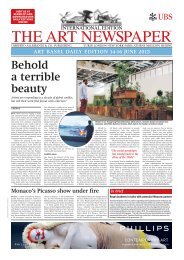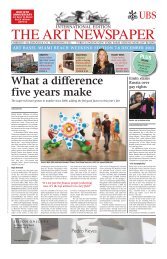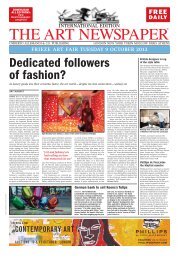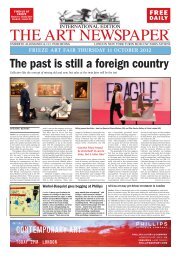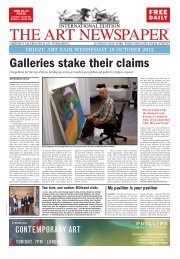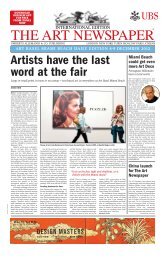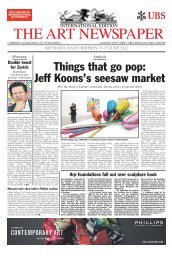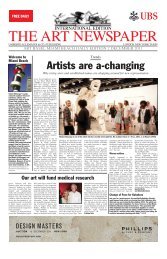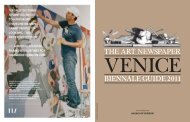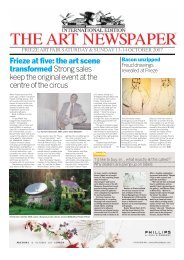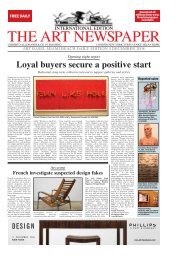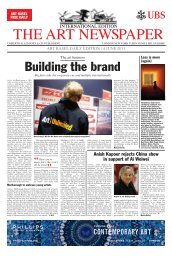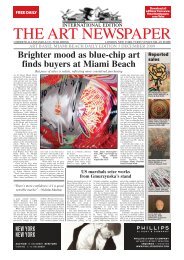frieze new york 2013, issue 2 - The Art Newspaper
frieze new york 2013, issue 2 - The Art Newspaper
frieze new york 2013, issue 2 - The Art Newspaper
Create successful ePaper yourself
Turn your PDF publications into a flip-book with our unique Google optimized e-Paper software.
BOOKS<br />
THE ART NEWSPAPER FRIEZE NEW YORK DAILY EDITION 11-13 May <strong>2013</strong> 13<br />
Don’t buy this, buy that<br />
This guide to building a collection is comprehensive but a little too polite<br />
AUTHORS: COURTESY OF THEA WESTREICH ART ADVISORY SERVICES. HOME: GENEVIEVE HANSON; COURTESY OF PHAIDON<br />
COLLECTORS’ HANDBOOK<br />
<strong>Art</strong> collectors are<br />
“ruthless, greedy,<br />
tyrannical and disreputable”,<br />
in the<br />
words of the art<br />
historian Kenneth<br />
Clark, and redeemed only by their<br />
possession of “one principle worth<br />
all the rest: the principle of<br />
delight”. Collecting <strong>Art</strong> for Love,<br />
Money and More, by the influential<br />
art advisers <strong>The</strong>a Westreich<br />
Wagner and Ethan Wagner, promises<br />
an insider’s insight into the<br />
small world populated by those<br />
people whose maladjustments<br />
finance the commercial art market.<br />
It is both a guide for those<br />
looking to start or expand a collection<br />
and a rumination on the compulsion<br />
to collect.<br />
<strong>The</strong> ten chapters into which the<br />
book is divided each address a simple<br />
<strong>issue</strong> pertaining to building a<br />
collection, from how to manage a<br />
budget appropriate to your means<br />
to dealing with gallerists, auction<br />
houses and dealers. <strong>The</strong> advice provided<br />
is drawn from the authors’<br />
own experience and from the historical<br />
examples of celebrated collectors<br />
such as John Quinn and<br />
Gertrude and Leo Stein. <strong>The</strong> text is<br />
rich with anecdotes that illustrate<br />
how the great collections were<br />
built around the aesthetic or intellectual<br />
preferences of visionary<br />
individuals, and these asides make<br />
the book a more diverting read<br />
than might be expected of a vade<br />
mecum to the art market.<br />
<strong>The</strong> book is written in a conversational,<br />
intimate tone that suggests<br />
the authors are experienced<br />
in putting people at ease.<br />
Discretion and diplomacy are further<br />
qualities essential to any art<br />
advisory service, so it is hardly surprising,<br />
though nonetheless disappointing,<br />
that even the most tepid<br />
criticism of any artist or gallery<br />
(and any good art adviser will have<br />
trenchant opinions on both) is<br />
prefaced by “some might say that”<br />
or “many people would consider<br />
that”. On those occasions when<br />
the authors do draw attention to<br />
familiar flaws in the operations of<br />
the blue-chip contemporary<br />
art market<br />
(“a hard look at<br />
other artists in<br />
[Gagosian Gallery’s]<br />
programme, and<br />
surely certain artists<br />
at other mega-galleries,<br />
begs the question:<br />
can high prices<br />
be sustained over<br />
time when artists<br />
fail to engender any<br />
serious critical and curatorial<br />
interest?”), readers are left to draw<br />
their own conclusions.<br />
<strong>The</strong> art world is plagued, or<br />
blessed, with endless scandal,<br />
intrigue and fallings-out. While the<br />
media attention afforded to these<br />
enmities and rivalries has undoubtedly<br />
contributed to the overall rise<br />
of the market, these internecine<br />
squabbles are also hugely influential<br />
upon the careers of individual<br />
artists, whose reputations depend<br />
upon those of the people who are<br />
buying and selling their work.<br />
Charles Saatchi is the subject of<br />
damnation by faint praise (in a<br />
chapter entitled “<strong>The</strong> Vicissitudes<br />
of the <strong>Art</strong> Market”), but the reader<br />
is left longing to know what the<br />
authors really think about the<br />
sway that he and others hold over<br />
individual artists and indeed entire<br />
movements. <strong>The</strong>ir reticence can<br />
occasionally frustrate, but it<br />
does not significantly impede<br />
the book’s primary aims.<br />
Collecting <strong>Art</strong>… reminds<br />
the reader that buying art is<br />
subject to the same rules as<br />
more mundane investments,<br />
and the authors are to be<br />
applauded for their efforts to<br />
demystify the process. As<br />
with any purchase, the buyer<br />
should be knowledgeable<br />
about the product and<br />
informed of its critical reception,<br />
should resist fads and should buy<br />
for the long term. But despite taking<br />
obvious pains not to explicitly<br />
condemn any motive that inspires<br />
the purchase of art, the authors<br />
clearly align themselves with a tradition<br />
that values the patronage of<br />
specific artists and the establishment<br />
of a publicly available legacy<br />
above short-term financial profit.<br />
In the book’s most interesting passage,<br />
they discuss the widespread<br />
anxiety about the appreciation of<br />
contemporary art, specifically the<br />
fear that inexperienced buyers<br />
who “view the market as an easyto-compute<br />
indicator of artistic significance”<br />
are skewing the production<br />
and critical reception of <strong>new</strong><br />
work. <strong>The</strong>ir conclusion—that quality<br />
will always, ultimately, be<br />
recognised—is convincingly argued<br />
and, perhaps not coincidentally,<br />
<strong>The</strong>a Westreich Wagner and Ethan<br />
Wagner—and a Warhol in their home<br />
reassuring to any readers making<br />
their first steps towards buying art.<br />
Readers should not expect the<br />
authors to share Clark’s appraisal<br />
of the peculiar personality traits<br />
that drive individuals to amass collections<br />
of objects that they often<br />
do not have the time or space to<br />
display. Instead, the titular “more”<br />
that they append to the all-pervading<br />
impulses of love and money is<br />
summarised as a combination of<br />
social status, “intellectual satisfaction”,<br />
“emotional stimulation”,<br />
egotism, a craving for public attention<br />
and the peculiarly human<br />
desire to leave a historical legacy.<br />
Yet none of these quite matches<br />
the capacity for “delight” that<br />
Clark identified, and, indeed, the<br />
book is less successful as an analysis<br />
of the compulsion to collect<br />
than as a handy guide to those<br />
already bitten by the bug.<br />
Benjamin Eastham<br />
Collecting <strong>Art</strong> for Love,<br />
Money and More<br />
Ethan Wagner and <strong>The</strong>a<br />
Westreich Wagner<br />
Phaidon, 192pp, hb, £22.95



